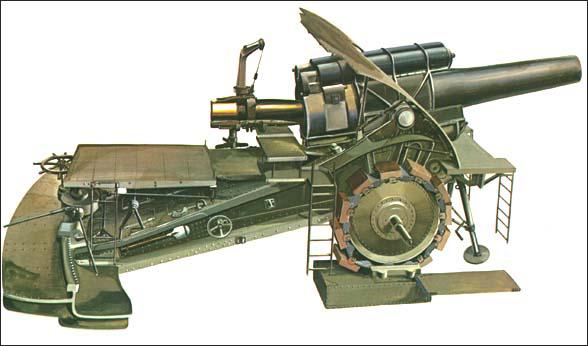Big Bertha
In 1900 Alfred Krupp's armaments factory at Essen, Germany, began building a 350-mm howitzer that could fire an 800 lb shell over 10,000 yards. In 1908 the German Army asked Gustav Krupp to build an improved version of this gun with the capability of destroying the heaviest fortification.
By 1912 Krupp had produced a 420mm weapon that fired a 2,100 lb shell over 16,000 yards. As it weighed 175 tons, it was designed to be transported in five sections by rail and assembled at the firing site. This concerned the German Army and they asked for it to be adapted to be moved by road. By 1914 company had produced a mobile howitzer called Big Bertha (named after Gustav Krupp's wife). This 43 ton howitzer could fire a 2,200 lb shell over 9 miles. Transported by Daimler-Benz tractors, it took its 200-man crew, over six hours to re-assemble it on the site.
On the outbreak of the First World War, two Big Berthas and several Skoda 30.5 howitzers were erected outside the fortress of Liege in Belgium. The first shells were fired on 12th August at the ring of 12 forts around the city. By the 15th August all the forts had either been destroyed or had surrendered. News of the success of this new weapon at Liege encouraged other countries involved in the conflict to produce large mobile guns.

Primary Sources
(1) Major Wesener was a German officer who worked on a Big Bertha at Liege on 12th August, 1914.
It was a memorable moment as the howitzer discharged the first shell on enemy soil at 1740 hours on August 12 against Fort Pontisse, on the south-eastern side of Liege. A hundred-fold cheer accompanied the shell as it howled and snorted along the high trajectory to its target. I was gratified that everything had turned out well, and that the eagerly-awaited opening of fire could be undertaken. Sixty seconds ticked by - the time needed for the shell to traverse its 4,340 yard high trajectory - and everyone listened in to the telephone report of our battery commander, who had his observation post 1,625 yards from the bombarded fort, and could watch at close range the column of smoke, earth and fire that climbed to the heavens.
(2) Lieutenant-General Leman was the commander of Belgian Army defending the Liege Forts.
We could hear the shells coming. We heard a rushing of air which increased in intensity until it became a furious hurricane roar and ended in a dreadful crash of thunder; fountains of earth and smoke were thrown into the air, and the whole earth shook.
(3) Report issued from the commander of Fort Pontisse (12th August, 1914)
Ventilation: very bad; the men were seized with stomach pains, diarrhoea, nausea and and inability to hold back their urine. The fort was reeking with explosive fumes from the outside. They tried to stop up the windows with mattresses but it was no use.
Latrines: the garrison used stinking boxes which were emptied into the channel; it became blocked, and the men were greatly inconvenienced.
